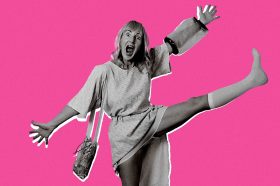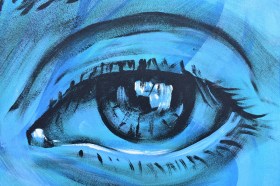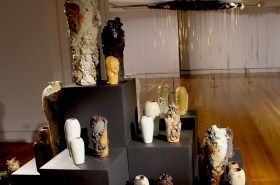Image via Shutterstock.
December is a time for contemplation – a time of looking ahead and dreaming big – but also a time of reflection and looking back over the year that was. At the end of another sometimes-turbulent year for the arts, here are some of the biggest stories we reported on over the past 12 months.
If you want to know more about visual arts news in 2017, meanwhile, check out Gina Fairley’s The Big List: the visual arts in 2017. On a sadder note, we’ve also compiled a list of all the sector legends we lost this year in our annual vale list.
JANUARY
Summer is supposed to be a time of lazing on beaches or in backyards, not a month when arts organisations with a 70 year history announce their closure. In January, the Tasmanian arts sector reeled in shock as Tasmanian Regional Arts (TRA) announced its impending closure. John Oster, Executive Director, Regional Arts Australia, told ArtsHub: ‘I want to make the point that there’s been no foul play, no mismanagement. This is just a situation where funding that was available is no longer available, and therefore the organisation has needed to take account of changed funding circumstances. It would be great if the Tasmanian government were able to consider the services of Tasmanian Regional Arts in the way that other state governments do.’
The same month, the National Association for the Visual Artist (NAVA) launched a new advocacy campaign – Fair Pay for Artists – while over in the west, the Chamber of Arts and Culture WA has launched its ‘Arts Improves Lives’ campaign in the lead up to the state election on 11 March.
FEBRUARY
One of the major stories in February was the announcement by the Australia Council for the Arts that the organisation had been forced to draw on its reserves to avoid even more devastating cuts to the small-to-medium sector – ongoing fallout from the shortsighted and damaging Brandis raid on the Australia Council in 2015.
In more positive news in February, we saw playwright Leah Purcell win the Victorian Premier’s Literary Award of $100,000 for her play, The Drover’s Wife; only the second time Australia’s richest writing prize has been award to a stage play. The 2017 awards were also notable for seeing women writers win six of the seven awards on offer.
The month also saw an announcement by Adelaide Fringe, made in response to criticism the previous year that it had become unaffordable for artists, that it would henceforth reduce internal ticketing charges for artists from 2018. ‘Removing inside charges makes participating in the Adelaide Fringe more affordable for all artists, especially those taking risks and first timers, and it also has a flow on effect for audiences and venues,’ said Adelaide Fringe CEO and Director Heather Croall.
MARCH
The biggest story in March was the much-anticipated return of Catalyst funds to the Australia Council. The announcement – the final nail in the coffin of George Brandis’ damaging National Program for Excellence in the Arts, came after many months of intensive sector lobbying, both publicly and behind the scenes, and after almost two years of chaos and disruption.
Later that month, Britain’s Cultural Learning Alliance provided new proof that arts education makes kids smarter, healthier and better adults. Closer to home, Opera Australia found itself in hot water, this time over the company’s alleged failure to invite a group of key artists back to oversee a remounted production of Carmen for Handa Opera on Sydney Harbour.
APRIL
April was not a kind month for the Northern Rivers arts community, who were devastated by floods associated with Tropical Cyclone Debbie. The city of Lismore was especially hard hit. ‘The whole city is like a bomb went off,’ NORPA’s General Manager, Patrick Healey, told ArtsHub.
In brighter news, Opera Queensland announced the appointment of their new Artistic Director in April, with Patrick Nolan promising to evolve the art form once he settles into the role. ‘If you’re not developing the form in new and different ways, then I think you’re failing as an arts organisation,’ he told us.
In Sydney, meanwhile, a new creative hub in Green Square announced its management team, while in Hobart, animal rights activists were up in arms over a proposed artwork by Hermann Nitsch at Dark Mofo.
The month’s other big story was the decision by the Federal Government to cut 29 arts or cultural professions – ranging from artistic director, actor, composer and painter to multimedia designer, museum technician and community arts worker – from the skilled visa list. The changes to visa laws were designed to save jobs for Australians.
MAY
Anecdotal evidence has long suggested a cultural imbalance on our main stages; in May, a new independent report attempted to provide quantitative data on the subject. ‘The vast majority of works are both written and directed by white people. And when you look at the people in positions of power at these institutions you start to see a correlation between each company’s season and those doing programming,’ the report’s author, Kim Ho, told ArtsHub.
Other stories we reported on in May included the announcement of $106.6 million for the creative industries in the Victorian budget; the development of a new Independent Theatre Agreement by Equity’s Independent Theatre Committee; and – as part of the #fairgoFairfax campaign – a rallying cry by Australia’s nine largest theatre companies in support of arts journalism.
JUNE
As winter began to bite, some good news stories emerged for the sector. In Tasmania, Launceston’s boutique Junction Arts Festival secured five years’ funding from the state government, ensuring the festival’s future until 2021, while in Queensland, the sector celebrated the state budget announcement of an additional $43.1 million for arts and culture over the next four years. South Australians had less to celebrate, however; their 2017-18 arts budget was targeted towards capital works and festivals, with no new money for individual artists and small-to-medium arts organisations despite concerted lobbying by the Arts Industry Council SA.
June also saw the announcement of a new, $4.6 million playwright development program at the Melbourne Theatre Company, while the orchestral sector welcomed a world-first report into workplace safety and the health of their musicians. And in Sydney, a new partnership was announced between Griffin Theatre and Australian Theatre for Young People (ATYP), ensuring that despite being homeless in 2018, ATYP would still be able to present a season of works.
JULY
The sector had a few reasons to celebrate in July – one of them being the annual Helpmann Awards presentation. We might bicker over the way awards are judged and the length of individual ceremonies but let’s face facts: everyone loves a reason to celebrate our friends’ and peers’ successes.
The month also saw the publication of a new report examining the growth of private giving in Australia. Private sector support for the arts in Australia (published 27 June 2017) found that, ‘overall private sector support [combining donations and sponsorship] for the arts in Australia is estimated to have grown over a period of six years, from $221.1 million in 2009–10 to between $268.5 million and $279.8 million in 2015–16.’
AUGUST
Perhaps the biggest story in August – and certainly one of the most-read – was the announcement of who would be running A New Approach – a $1.65M program intended to champion Australia’s cultural sector. Two non-arts organisations – one an academic body, the other a communications firm with close ties to government agencies and the corporate sector – were the surprise appointees, with the news raising some eyebrows throughout the sector. We had to wait until November for the news that arts and cultural sector leader, advocate and strategist Kate Fielding had been appointed by The Myer Foundation, Tim Fairfax Family Foundation and Keir Foundation as Program Director for A New Approach.
Also in August, we learned that Australian Dance Theatre (ADT) had successfully lobbied the South Australian government for $340,000 to transform an old picture theatre into a new performance hub, and we discovered that the future of the Tasmanian Theatre Company was again under threat following a dramatic reduction in funds through Arts Tasmania’s Organisations Investment Program.
SEPTEMBER
In September came the news that private sector support for the arts had hit a record $95.7 million, according to figures released by the Australian Major Performing Arts Group (AMPAG). Speaking of AMPAG companies, one of them found itself in hot water this month, over a decision not to publically support the Yes campaign for marriage equality. Sydney Symphony was slammed on social media for their stance – one at odds with outmost every arts organization in the country, large or small – by leading arts identity Leo Schofield. Following further criticism and internal dissent – including pro-marriage equality statements from the members of the SSO’s orchestra and even their incoming Chief Executive Officer, Emma Dunch, Sydney Symphony quickly changed their tune.
OCTOBER
As we rolled into December, delegates at the Australian Theatre Forum (ATF) in Adelaide were reminded of the importance of intersectionality when thinking about the arts. Also at the ATF, delegates heard from Australian Theatre for Young People (ATYP), who have documented the significant benefits young people experience when they actively engage with the theatre – including a reduction in anxiety levels more significant than in any program to date specifically designed to make young people less anxious.
Mental health was again on the agenda, with the announcement of a new, national alliance formed to champion artists’ wellbeing; the latest Theatre Network Australia (TNA) salary survey revealed the hard facts of our fragile sector, and we celebrated the long-overdue return of copyright to the Namatjira family after an eight year and more campaign.
NOVEMBER
Some sad news this month, with news of two much-admired companies closing down: Hobart’s Loud Mouth Theatre Company, and Melbourne dance/physical theatre company KAGE. And while we also found time to celebrate, following the announcement the Yes vote for marriage equality had triumphed, on a more serious note the sector began having discussions about sexual harassment and assault – discussions which are still ongoing.
In Queensland, meanwhile, the focus was also on the state election, with the arts lobby extracting campaign promises from all the major parties over the following weeks. Brisbane Powerhouse announced a new, $300,000 artist support program to help encourage artists to stay and work in their home state, and the Commonwealth Games revealed the names of those artists assisting with the creation of next year’s opening and closing ceremonies.
Finally, November also saw the release of new research by the Australia Council, indicating that artists’ incomes have declined and the gender pay gap is widening.
DECEMBER
And so to the current month, and some stories still fresh in our minds. A new festival was announced for Adelaide, championing dance in all its forms; venerable arts magazine RealTime released its final issue; indie theatre-makers condemned sexual harassment and MEAA’s survey revealed the severity of the issue across the theatre sector nationally. Finally, ending the year on a note of optimism, our South Australian colleagues released a 40 year creative vision in the lead-up to next year’s state election. Bring on 2018!





